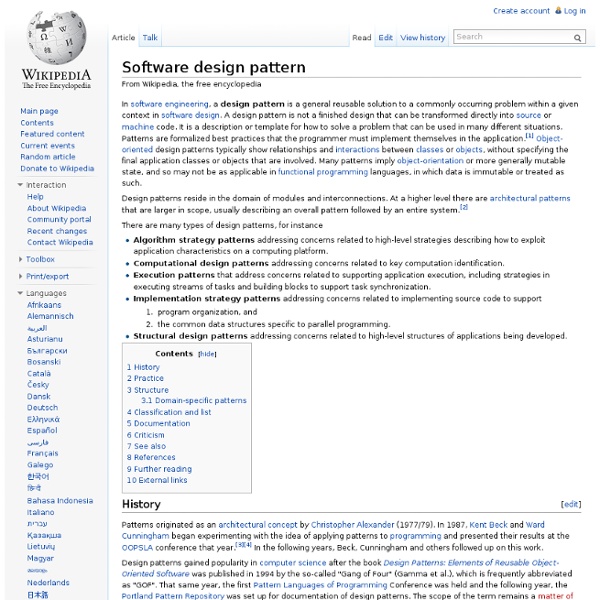Design pattern (computer science)

AntiPatterns: The Survival Guide
Whereas patterns are good ideas that can be re-applied to new situations, AntiPatterns: The Survival Guide looks at what goes wrong in software development, time and time again. Most software projects fail According to new research, success in 68% of technology projects is "improbable." Our deadliest hit list begins with the Blob, where one object does most of the work in a project, and proceeds to Continuous Obsolescence, where technology changes so quickly that developers can't keep up. Also, we have defined antipatterns oriented toward management problems with software (including Death by Planning and Project Mismanagement, along with several other antipatterns, that help define why so many software projects are late and over budget). Learn how to avoid a crash In this book we suggest ways to overcome antipatterns and improve software productivity in "refactored solutions" that can avoid some of these obstacles. This is a realistic book, a mix of "Dilbert" and software engineering.
Home - Pencil Project
Patron de conception
Un article de Wikipédia, l'encyclopédie libre. Pour les articles homonymes, voir Patron. En informatique, et plus particulièrement en développement logiciel, un patron de conception (en anglais : design pattern) est un arrangement caractéristique de modules, reconnu comme bonne pratique en réponse à un problème de conception d'un logiciel. Il décrit une solution standard, utilisable dans la conception de différents logiciels[1]. Les patrons de conception décrivent des procédés de conception généraux et permettent en conséquence de capitaliser l'expérience appliquée à la conception de logiciel. Ils ont une influence sur l'architecture logicielle d'un système informatique. Les types de patrons[modifier | modifier le code] Les patrons de conception ne sont ni des patrons d'architecture ni des idiotismes de programmation. Description[modifier | modifier le code] Les patrons servent à documenter des bonnes pratiques basées sur l'expérience. Histoire[modifier | modifier le code] Adapter Bridge Builder
Architecture Patterns
Introduction | US Treasury Architecture Development Guidance (TADG) | IBM Patterns for e-Business | Some Pattern Resources This chapter provides guidelines for using architecture patterns. Introduction Patterns for system architecting are very much in their infancy. They have not (as yet) been integrated into TOGAF. Background A "pattern" has been defined as: "an idea that has been useful in one practical context and will probably be useful in others" [Analysis Patterns - Reusable Object Models]. In TOGAF, patterns are considered to be a way of putting building blocks into context; for example, to describe a re-usable solution to a problem. Patterns offer the promise of helping the architect to identify combinations of Architecture and/or Solution Building Blocks (ABBs/SBBs) that have been proven to deliver effective solutions in the past, and may provide the basis for effective solutions in the future. Content of a Pattern Name Problem Context Forces Solution Resulting Context Examples Rationale
Design Patterns
In software engineering, a design pattern is a general repeatable solution to a commonly occurring problem in software design. A design pattern isn't a finished design that can be transformed directly into code. It is a description or template for how to solve a problem that can be used in many different situations. Uses of Design Patterns Design patterns can speed up the development process by providing tested, proven development paradigms. Often, people only understand how to apply certain software design techniques to certain problems. In addition, patterns allow developers to communicate using well-known, well understood names for software interactions. Creational design patterns These design patterns are all about class instantiation. Structural design patterns These design patterns are all about Class and Object composition. Behavioral design patterns These design patterns are all about Class's objects communication. Criticism Targets the wrong problem Lacks formal foundations
Linkers and Loaders
Ajax Design Patterns - Michael Mahemoff
Related:
Related:



